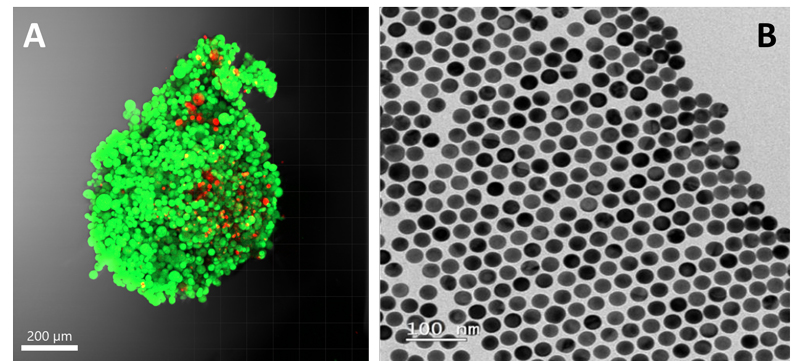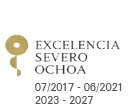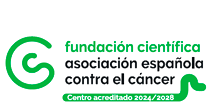
2023/12/20
Nanotechnology to understand the behavior of tumors
Researchers from CIC bioGUNE and CIC biomaGUNE collaborated on a study, utilizing SERS technology, uncovering a novel form of interaction between tumor cells and their environment.
The study, published in the journal Proceedings of the National Academy of Sciences of the United States of America (PNAS), demonstrates the potential of SERS spectroscopy for cancer metabolism research.
A study conducted by predoctoral researcher Pablo S. Valera, recently published in PNAS, has demonstrated the potential of surface-enhanced Raman spectroscopy (SERS) to explore metabolites secreted by cancer cells in cancer research. The study, led by Ikerbasque Professors Arkaitz Carracedo (from CIC bioGUNE) and Luis Liz Marzán (from CIC biomaGUNE), with the participation of other researchers from both centers – members of BRTA -, provides valuable information to guide more specific experiments that reveal the function of such secreted metabolites in the tumor microenvironment, potentially leading to new therapeutic strategies.
The tumor microenvironment is a complex ecosystem formed by interactions between tumor and healthy cells. It is a dynamic pseudo-organ that determines cancer development and progression. While traditional focus has been on protein-mediated intercellular communication, attention has recently shifted to metabolites (or small compounds) secreted by tumors into the extracellular space.
Traditional tracking techniques for these metabolites in complex cellular contexts are limited, but surface-enhanced Raman spectroscopy (SERS) has emerged as a promising alternative due to its simplicity of operation. In this study, a SERS-based strategy is proposed "to investigate metabolites secreted by tumor cells lacking methylthioadenosine phosphorylase (a common genetic event associated with poor prognosis in various cancers, such as breast cancer and glioblastoma)," explains Valera. SERS "is a spectroscopic technique that uses gold nanoparticles to detect molecules in a biofluid. It is a fairly fast technique with no need for sample pre-treatment," he adds.
Cellular communication produced by metabolites secreted by tumor cells:
Through the use of SERS, researchers have discovered that these cells secrete purine metabolites, which can be metabolized by healthy cells, leading to molecular changes consistent with cancer aggressiveness, explaining the never-before-seen reprogramming of the tumor environment in cancers with methylthioadenosine phosphorylase suppression. "We have been able to detect this metabolite not only in tumor cells but also in the rest of the healthy cells in contact with the tumor cells. In other words, we have detected that there is a relationship between tumor cells and healthy cells through this metabolite, and moreover, it causes a change in the behavior of healthy cells to, in a way, support tumor development," comments Valera. It is worth mentioning that "unravelling the complexity of such interactions in cancer patients could, in turn, pave the way for new therapeutic approaches," he adds.
The success of applying SERS in this study demonstrates that this technology could streamline the ability to quickly capture metabolic interactions in complex environments. In fact, the straightforward and rapid signal acquisition in SERS, coupled with its high sensitivity, meets the requirements to be a frontline tool that can subsequently guide more specific analyses. A complete view of the metabolic state of the tumor microenvironment can be achieved through monitoring with complementary techniques. It is also important to note that an effective synergy between SERS and other analytical methods has been demonstrated.
Reference: Pablo S. Valera, Javier Plou, Isabel García, Ianire Astobiza, Cristina Vierac, Ivan R. Sasselli, Arkaitz Carracedo & Luis M. Liz-Marzán. Proc. Natl. Acad. Sci. U.S.A. DOI: 10.1073/pnas.2311674120
About CIC bioGUNE
The Centre for Cooperative Research in Biosciences (CIC bioGUNE), member of the Basque Research & Technology Alliance (BRTA), located in the Bizkaia Technology Park, is a biomedical research organisation conducting cutting-edge research at the interface between structural, molecular and cell biology, with a particular focus on generating knowledge on the molecular bases of disease, for use in the development of new diagnostic methods and advanced therapies.
About CIC biomaGUNE
The Cooperative Research Center in Biomaterials (CIC biomaGUNE), member of the Basque Research and Technology Alliance (BRTA), carries out cutting-edge research at the interface between Chemistry, Biology and Physics with special attention to the study of properties of biological nanostructures at the molecular scale and their biomedical applications. Recognized in 2018 as a “María de Maeztu” Unit of Excellence for meeting excellence requirements, which are characterized by a high impact and level of competitiveness in its field of activity, on the world scientific stage.
About Ikerbasque
Ikerbasque - Basque Foundation for Science - is the result of an initiative of the Department of Education of the Basque Government that aims to reinforce the commitment to scientific research by attracting, recovering and consolidating excellent researchers from all over the world. Currently, it is a consolidated organization that has 290 researchers/s, who develop their work in all fields of knowledge.
About BRTA
BRTA is an alliance of 4 collaborative research centres (CIC bioGUNE, CIC nanoGUNE, CIC biomaGUNE y CIC energiGUNE) and 12 technology centres (Azterlan, Azti, Ceit, Cidetec, Gaiker, Ideko, Ikerlan, Lortek, Neiker, Tecnalia, Tekniker and Vicomtech) with the main objective of developing advanced technological solutions for the Basque corporate fabric.
With the support of the Basque Government, the SPRI Group and the Provincial Councils of the three territories, the alliance seeks to promote collaboration between the research centres, strengthen the conditions to generate and transfer knowledge to companies, contributing to their competitiveness and outspreading the Basque scientific-technological capacity abroad.
BRTA has a workforce of 3,500 professionals, executes 22% of the Basque Country's R&D investment, registers an annual turnover of more than 300 million euros and generates 100 European and international patents per year.
See a large version of the first picture





